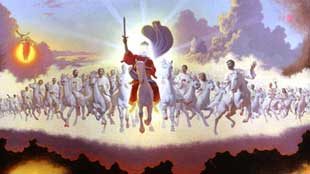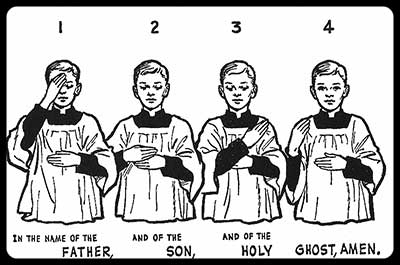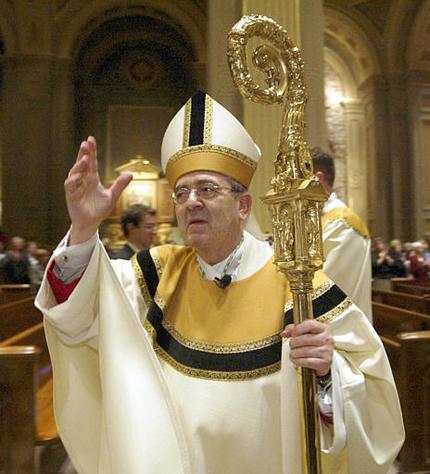
IMPORTANT: In Biblical prophesy, a beast symbolises a kingdom, government or form of administration.
The Roman Catholic Church admits to having a mark that it gives to its followers, and the word it uses to describe that mark is the same used in the Book of Revelation to describe the mark of The Beast. All references below are from the Roman Catholic Church Magisterium.
Nova Vulgata: Rev. 13:16-17… "Et facit omnes pusillos et magnos et divites et pauperes et liberos et servos accipere characterem in dextera manu sua aut in frontibus suis, et ne quis possit emere aut vendere, nisi qui habet characterem, nomen bestiae aut numerum nominis eius. "
Characterem = mark of the Beast.
The Seventh Session DECREE ON THE SACRAMENTS ; CANON IX of The Council of Trent confirms that this mark is given in the sacraments of baptism, confirmation and holy orders.
The original Latin Trent text reads: "Si quis dixerit, in tribus sacramentis, baptismo scilicet, confirmatione et ordine, non imprimi characterem in anima, hoc est signum quoddam spirituale et indelebile, unde ea iterari non possunt: a. s."
Translated in English - "If any one saith, that, in the three sacraments, Baptism, to wit, Confirmation, and Order, there is not imprinted in the soul a character (characterem), that is, a certain spiritual and indelible Sign, on account of which they cannot be repeated; let him be anathema" (excommunicated).
This Mark is alleged to be indelible, given through the sign of the cross on the subject's forehead by the right hand of the priest or bishop.

Scripture clearly describes the Mark of the Beast as being given in the forehead and/or right hand. In 'holy' baptism the adult catechumenate, for example, receives the Mark in this way: The priest/bishop makes the sign of the cross on the catechumenate's forehead with his right thumb, saying, "N., receive the cross on your forehead. By this sign of his love Christ will be your strength….." [Source: The Rites of the Catholic Church, Pueblo Pub., NY,1976]. This sign of the cross was introduced in the church of Rome in 315 AD.
Of course, it is through the sacrament of baptism that one is brought into the fold of holy Mother the Church. No one can enter this kingdom without the sacrament of 'holy' baptism, which mandates the priest/bishop mark that person with the sign of the cross on their forehead. According to Rev. 13:12-14, The Beast does not personally Mark everyone. His representatives have been given special authority from him to that end.
The tradition of Lent's Ash Wednesday is a visible example whereby we see those in the Beast's kingdom receiving his Mark. It is by the right hand of the one giving it that the mark is received in the forehead of his subjects.
In the sacrament of confirmation, the bishop anoints the forehead of the one to be confirmed with oil using his right thumb. In so doing, he says, "Accipe Signaculum Doni Spiritus Sancti." This phrase is literally translated into English as, "Receive the mark with the gift of the Holy Spirit."
By using the Oxford Latin Dictionary, one discovers that the Latin word, "accipe," is derived from the word, "accipere," defined "to take what is offered or given; to receive willingly." The root of the word, "signaculum" is "signo," defined "to mark with any distinguishable sign." Thus, the one confirmed "receives the mark."
The authoritative Douay-Rheims Bible translates Rev. 13:16-17 as: "16 And he shall make all, both little and great, rich and poor, freemen and bondmen, to have a CHARACTER in their right hand, or on their foreheads. 17 And that no man might buy or sell, but he that hath the CHARACTER, or the name of the beast, or the number of his name." Thus, in the sacrament of confirmation we see a mark, CHARACTEREM, received on the forehead, in the sign of the cross, through the agency, power and authority of the bishop using his right hand. The bishop has himself received the indelible marks of baptism, confirmation and holy orders on his forehead in the sign of a cross.
Related links
The miter, a hat worn by Roman Catholic bishops, was purposefully designed in this fashion because it is intended to represent two-horns. I quote Bruno Bernard Heim, in his exquisite book, Heraldry in the Catholic Church, Its Origins, Customs and Laws, (New Jersey: Van Duren, 1978); p. 62:
"As already mentioned the mitre has undergone a whole series of transformations since its introduction in the liturgy. At the dawn of the Eleventh Century it was it was conical or hemispherical. Later it was divided from front to back. Since about 1125 it has been made up of two pointed pieces called HORNS, rising from each side and slightly inclined toward each other, held together by the lining. The Twelfth Century mitre no longer had the HORNS at the side, but fore the aft of the head." Mr. Heim, the designer of John XXIII's coat of arms, adds that Innocent III explained the symbol of the two-horns as representing the two Testaments, Old and New. Of course, by that explanation we are to understand that the bishops are ones who follow the Bible, the rule of faith for Christians.
So here we have another unlikely fulfillment of prophecy. Not only does the Roman Catholic priesthood, including bishops, give and receive the indelible Mark, CHARACTEREM, as described in Rev. 13:16-17, but its bishops wear two-horned miters, as described in Rev. 13:11.
The Beast of the Book of RevelationDesign by W3layouts